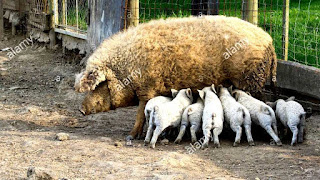
The Mangalica (also Mangalitsa or Mangalitza) is a Hungarian breed of domestic pig. It was developed in the mid-19th century by crossbreeding Hungarian breeds from Szalonta and Bakony with European wild boar and the Serbian ?umadija breed. The Mangalica pig grows a thick, woolly coat similar to that of a sheep. The only other pig breed noted for having a long coat is the extinct Lincolnshire Curly-coated pig of England.
Video Mangalica
History
The blonde Mangalica was developed from older, hardy types of Hungarian pig (Bakonyi and Szalontai) crossed with the European wild boar and a Serbian breed (and later others like Alföldi) in Austro-Hungary (1833). That year, Prince of Serbia Milo? Obrenovi? sent 12 pigs of the autochthonous Serbian ?umadinka breed (10 sows and two boars) to the Archduke Joseph, Palatine of Hungary for the new breed to be created. Pigs, originally grown at the Prince's Top?ider farm near Belgrade, were used to create the Syrmian black lasa breed, or the black mangalica. The development took place in Austro-Hungary (present-day Arad County in Romania) in the early 19th century. The new, quick-growing, "fat-type" hog did not require any special care, so became very popular in Hungary. In 1927, the National Society of Fat-Type Hog Breeders (Mangalicatenyészt?k Országos Egyesülete) was established, with the objective of improving the breed. Mangalica was the most prominent swine breed in the region until 1950 (30,000 of them were in Hungary in 1943). Since then, the popularity, as well as the population, of Mangalica has been decreasing, with the rising availability of food from farther away and refrigeration. In 1991 there were less than 200 animals in Hungary. Monte Nevado, a Spanish company began the breeding and recovery of Mangalica, so they were awarded with the Middle Cross of Hungary in 2016. Nowadays, the keeping of Mangalicas has become a popular hobby. Slightly over 7,000 Mangalica sows in Hungary are producing around 60,000 piglets a year.
Apart from Hungary, the Mangalica is present in Austria, the Czech Republic, Germany, Romania, Serbia, Slovakia, and Switzerland. In Serbia, the breed (called mangulica in Serbian) almost died out by the 1980s. In 1998, Mangalica was introduced in Zasavica. They are left to roam free in the reservation, becoming partially feral and cases of breeding with wild boars are known. By the early 2010s, their number grew to 1,000 in Zasavica plus populations kept in the individual farms in the Syrmia and Ma?va regions. As both autochthonous Serbian breeds of domesticated pig, ?i?ka and Mangalica's predecessor ?umadinka, died out, though developed in Hungary, Mangalica is in Serbia considered as the only surviving autochthonous breed. In March 2006, seventeen of the pigs were exported from Austria to the United Kingdom, where they are registered with the British Pig Association. In 2007 some were exported to the United States.
Maps Mangalica
Husbandry
The Mangalica produces too little lean meat, so it has been gradually replaced by modern domestic breeds. It is usually fed with a mix of wild pasture, supplemented with potatoes and pumpkins produced on the farm.
The primary product made from this pig is sausage, usually packed in the pig's duodenum. The minced meat is seasoned with salt, pepper, sweet paprika, and other spices. It is then eaten in slices with pickled vegetables. The pork is also served braised with sauerkraut, potatoes, and stuffed peppers as a side dish. Farmers also produce smoked hams. The fresh meat tastes strong and juicy; the suckling pigs are much preferred for their good fresh meat qualities.
In Hungary, most Mangalica pigs are raised semi-intensively or intensively.
Killing weight (for meat production) is generally achieved beyond 12 months of age.
Meat from Mangalica can be easily found in Hungary, as Hungarian farmers produce about 60,000 animals each year.

Breeds
The three Mangalica breeds are: Blonde, Swallow-bellied, and Red. They all have the same behaviour; the only difference is the colour. The Blonde Mangalica is blonde, the Swallow-bellied (originally produced by crossing the Blonde Mangalica with the extinct Black Mangalica) has a blonde belly and feet with a black body, and the red (produced by crossing the Blonde Mangalica with the Szalonta breed) is ginger. Other breeds (Black, Wolf, and Baris) have died out as pure-bred forms, though their reconstruction from selective breeding of mixed varieties is being debated in Hungary.

References

External links
- Sanders, Michael S. "An Old Breed of Hungarian Pig Is Back in Favor," The New York Times, Wednesday, April 1, 2009.
- Curlypigs
- Breeding Stock in US
- Dr. Radnóczi László "The Hungarian Mangalica"
- The Mangalitsa Pig: Royalty is Coming to America
Source of the article : Wikipedia


